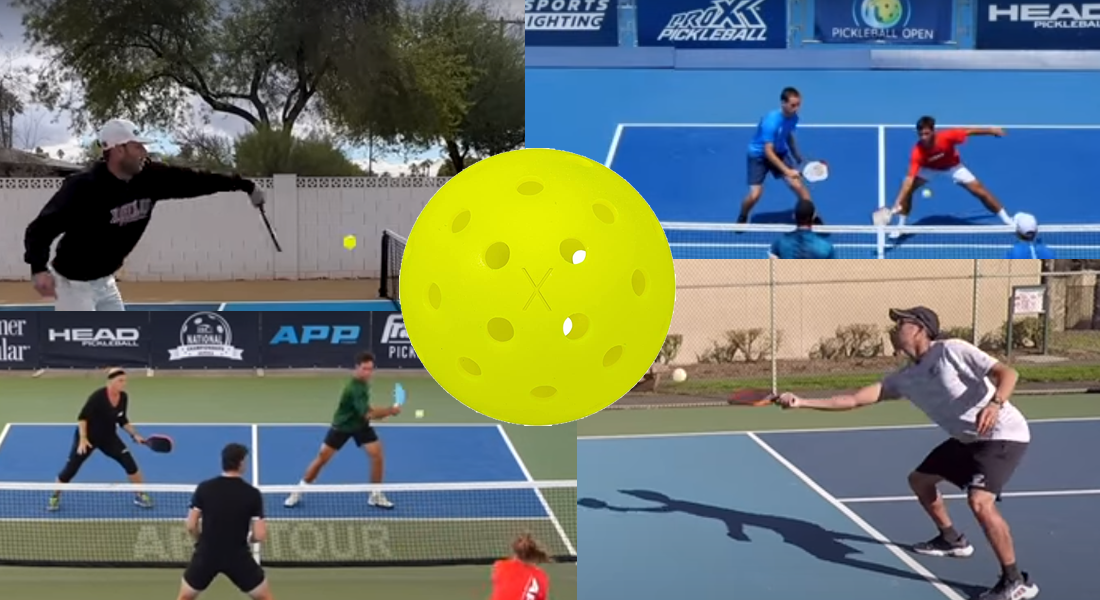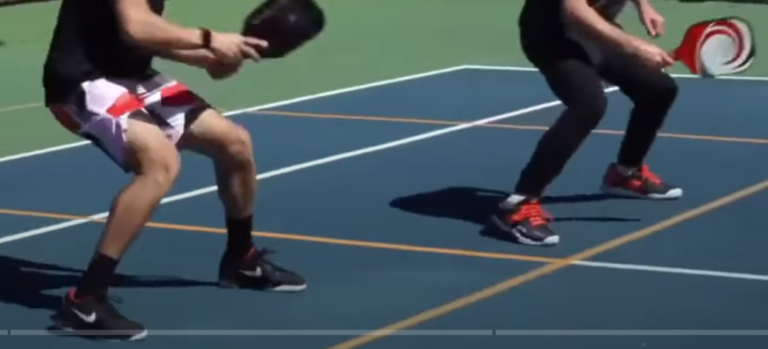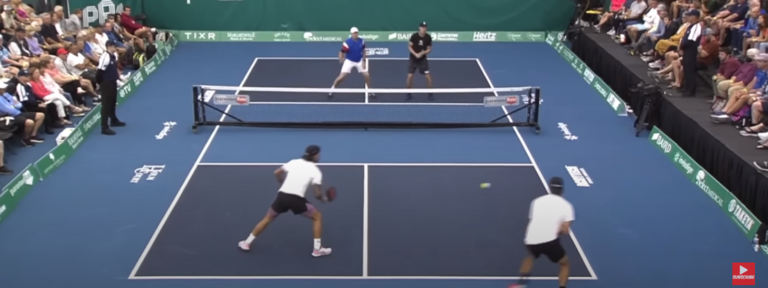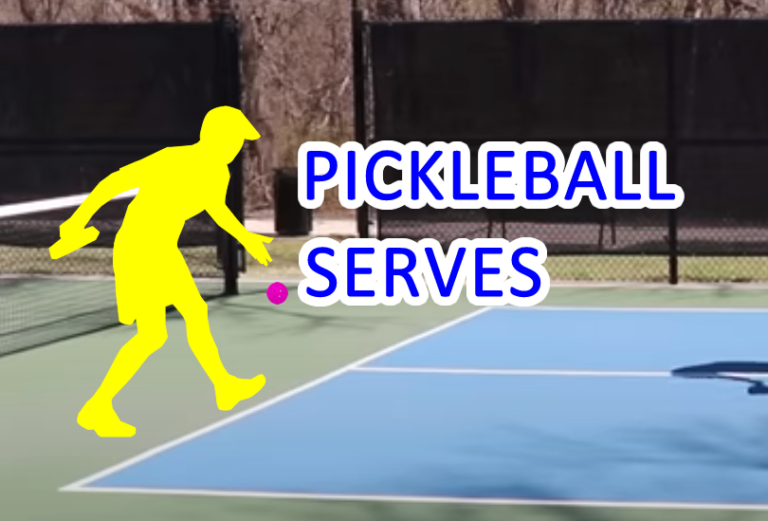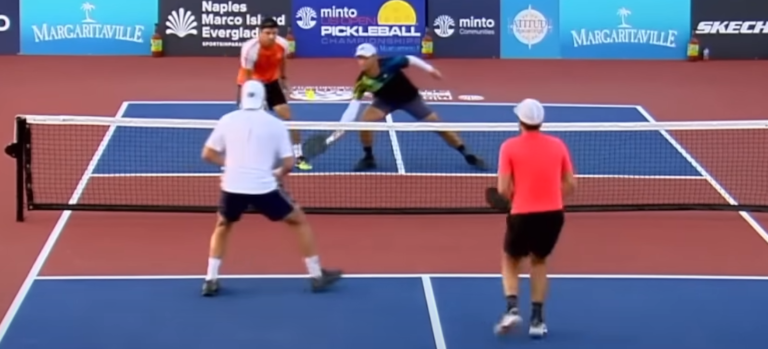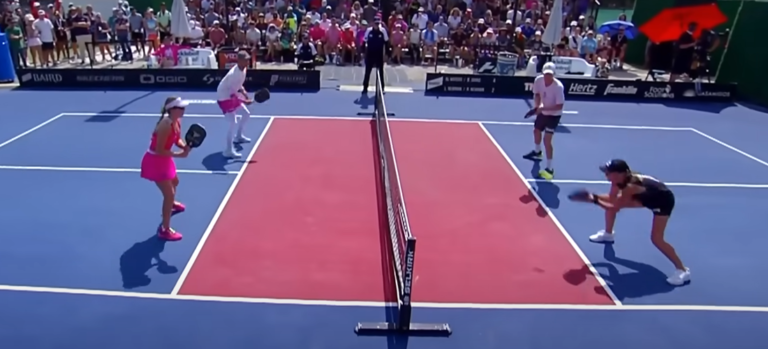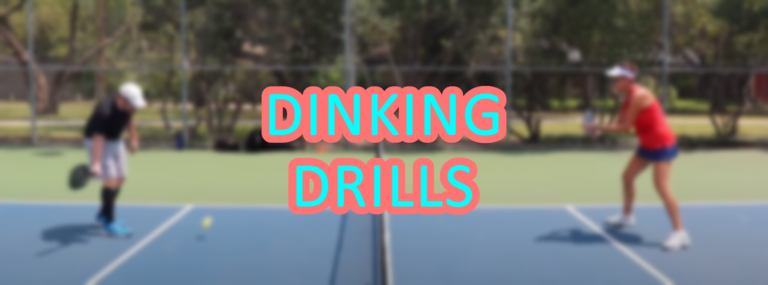Volley Shots: Essential Skills for Pickleball Players
Pickleball is a fast-paced and exciting sport that requires precision, quick reflexes, and good court awareness. Volley shots are an integral part of the game and mastering them can give you a distinct advantage on the court. In this blog post, we will explore how to improve your pickleball volley shot so that you can take your game to the next level!
What is a Pickleball Volley Shot?
In pickleball, a volley shot refers to hitting the ball in the air before it bounces on your side of the court. It is a fundamental technique used during gameplay, particularly near the net. When you volley, you intercept the ball mid-air, aiming to return it to your opponents without allowing it to bounce.
Volley shots are commonly executed when the ball is hit high. They provide an opportunity to attack or maintain control of the rally. Typically performed while standing close to the net, often as part of a strategy to maintain a strong position and prevent the ball from bouncing low, which could give your opponents an advantage.
To execute a volley shot effectively, you need to be positioned well, with your feet planted and your body balanced. Keep your paddle in front of you, ready to meet the ball, and use a controlled swing to direct the ball back to your opponents’ side of the court. It’s important to maintain a steady hand and good eye-hand coordination to accurately direct your volleys.
Tips to Executing Effective Volley Shots
To execute an effective pickleball volley shot, follow these steps:
Proper positioning
Stand near the net with your feet shoulder-width apart. Keep your knees slightly bent and be prepared to move quickly in any direction.
Ready position
Hold your paddle out in front of you, using a firm but relaxed grip. Keep your paddle face open, parallel to the net.
Watch the ball
Pay close attention to the ball as it approaches. Focus on its speed, trajectory, and spin, which will help you determine the appropriate timing and angle for your volley.
Hit Within Your Comfort Zone
One of the challenges that players face when at the non-volley zone line is when to either hit a volley or let the ball bounce. Here’s a way to figure out the optimal distance where you can volley balls coming at you. First, stand at the NVZ line. Bend your knees and stretch out your paddle hand in front of you as far as it will go. Your comfort zone will be about 3 to 4 inches within that area.
Contact point:
Make contact with the ball in front of your body and at the height of your waist or slightly higher. This ensures that you intercept the ball at its highest point, giving you more control and reducing the chances of hitting into the net.
Controlled swing
Use a compact and controlled swing for your volley shot. Avoid big swings that could compromise your balance and accuracy. Instead, aim for a short, punch-like motion. Keep your wrist firm but flexible, allowing for slight adjustments as needed.
Direct the shot
Aim to direct the ball to a specific area on your opponents’ side of the court. Focus on placement rather than power. Look for openings or areas where your opponents are not well-positioned, making it more challenging for them to return the shot effectively.
Recover quickly
After executing your volley, return to the ready position as soon as possible. Be prepared to adjust and respond to your opponents’ return shot.
Remember, practicing volleys and getting familiar with the timing and control required will help you improve your execution. Additionally, playing with experienced players and receiving feedback can greatly contribute to refining your technique.
Drop Volley Shots
In pickleball, a drop volley is a specific type of volley shot that involves hitting the ball softly and with precision, causing it to drop just over the net. The objective of a drop volley is to place the ball close to the net on your opponents’ side, making it difficult for them to reach and return the shot effectively.
Keep yourself low when executing a drop volley. Hold your paddle face open at an angle of about 45 degrees. Try to put some arc and backspin on the ball to keep it low. Try to absorb some pace off the ball by keeping your grip loose. Use angled shots to keep your drop shallow in the court. This has the added advantage of making your opponents run.
Tips for Effective Drop Volleys
- Use a gentle and controlled swing for your drop volley. The key is to make minimal contact with the ball. Generate just enough force to lift the ball over the net. Drop it close to the net on your opponents’ side.
- Make contact with the ball slightly below its center, ensuring that the ball gets a bit of backspin. This backspin helps the ball to clear the net and fall quickly after crossing the net. This will reduce your opponents’ reaction time.
- Aim to place the drop volley just over the net and close to the sideline. Target an area that your opponents will have difficulty reaching. The ideal placement is often near the sideline and deep into your opponents’ court. This will force them into a defensive position and limit their options for an effective return.
- After making contact with the ball, allow your paddle to continue its forward motion and follow through smoothly. Quickly recover to the ready position, anticipating your opponents’ return shot.
Drop volley shots are finesse shots that requires touch and accuracy rather than power. Practice and experience will help you develop the necessary feel and control to execute this shot effectively in various game situations.
Swing Volley Shots
In pickleball, a swing volley refers to hitting the ball with a more pronounced and full swing while it is in the air, before it bounces on your side of the court. It is a shot that combines the characteristics of a volley and a groundstroke. It incorporates a larger swing motion to generate more power and potentially create offensive opportunities.
Use the swing volley when the ball higher, typically as it is coming off a pop-up shot. It allows you to step back from the net slightly to create space for the bigger swing. You can also hit this shot when you are in the transition zone on the way to the net. It can be an effective shot for offensive play when executed properly. The swing volley allows you to hit the ball with more pace and potentially put your opponents on the defensive.
Tips for Effective Swing Volleys
- Watch your timing and footwork. As the ball approaches, time your swing so that you make contact at the optimal moment. Take a small step forward with your front foot and transfer your weight to it, rotating your body and hips to generate power for the shot.
- Execute a larger swing with your paddle, similar to a groundstroke. Use a controlled but forceful motion to make contact with the ball in front of your body. Allow your body and arms to follow through the swing to maximize power and control.
- Aim to direct the swing volley shot to a specific area on your opponents’ side of the court. Look for openings or areas where your opponents are not well-positioned. This shot can catch them off-guard or force them in a defensive response.
- After making the swing volley, recover quickly and return to a balanced and ready position, anticipating your opponents’ return shot.
It’s important to note that swing volley shots require good timing, coordination, and practice. While they can be effective offensive shots, they also carry a higher degree of risk due to the larger swing and potential for errors. Therefore, it’s essential to assess the situation and use swing volleys selectively, depending on the game circumstances.
Punch Volley Shots
A punch volley shot is a quick and short, yet forceful, volley used to surprise and overpower opponents during fast-paced exchanges at the non-volley zone (commonly known as the “kitchen”).
The punch volley is typically hit with a firm, compact stroke using a “punching” or quick-punching motion, hence the name. It is not a full swing like a groundstroke or a regular volley. Instead, players use a short and precise motion to make contact with the ball just in front of their body.
Key Characteristics of the Punch Volley
- Placement: When you use a punch volley, try to hit the ball down towards your opponent’s non-volley zone which is close to the net. This makes it difficult for your opponent to send back a powerful shot.
- Speed: Use the speed from your opponent’s shot to hit your return faster and more swiftly.
- Disguise: A well-executed punch volley is difficult for the opponent to anticipate, as it requires a quick reaction due to its rapid nature.
- Surprise Factor: Hit your opponent with the punch volley when they don’t expect it. The minimal backswing also helps to disguise the shot. This is a great way to respond quickly at the net!
- Counterattacking: You can use the punch volley to counterattack and throw your opponent off balance. This shot will help you take control of the net.
To perform a punch volley effectively, players need good hand-eye coordination, quick reflexes, and the ability to adjust their positioning near the net. It is crucial to maintain a balanced and stable stance, as the punch volley requires rapid movement and reaction times.
Players may use the punch volley in various situations, such as when returning an opponent’s fast and low shots, or when reacting to a drop shot that lands close to the net. It is a valuable tool in the arsenal of advanced pickleball players looking to gain an advantage at the non-volley zone and control the pace of the game.
Roll Volley Shots
A roll volley is a type of shot using a gentle, controlled motion to hit the ball softly and with backspin, causing it to “roll” smoothly over the net and land softly in the opponent’s court. The goal of the roll volley is to create a shot that is challenging for the opponent to attack or return aggressively, making it an effective offensive strategy at the non-volley zone (kitchen).
Key Characteristics of the Roll Volley
- Backspin: You can generate backspin on the ball with a roll volley, and this will cause it to rotate backward as it moves forward. This backspin helps to reduce the speed of the ball and make its landing softer.
- Placement: When you do a roll volley, aim for a spot close to the net on your opponent’s side. This makes it hard for them to hit a powerful shot or volley back with force.
- Controlled Stroke: You need to finesse and precision your shot, using a gentle swing motion. Focus on guiding the ball instead of hitting it too hard.
- Dropping the Ball: You can perform a successful roll volley by letting the ball drop lower than your waist level before making contact with it. This helps you add backspin and control its trajectory.
- Neutralizing Power Shots: When the other player hits a fast and hard shot, you can use the roll volley to defend. This will slow down the pace of the game and keep the ball from bouncing back too hard.
- Approaching the Net: Players typically employ the roll volley when positioned close to the net, usually in the non-volley zone, after a drop shot or a soft shot from their opponents.
The roll volley requires good touch and finesse, and it is an essential skill for players who want to control the game at the net and engage in skillful, tactical play. When executed effectively, the roll volley can force opponents to hit difficult returns and create opportunities to take control of the point. Players should practice the roll volley to become proficient at using it in different match situations and to refine their ability to vary the shot’s depth and direction.
Summary
Pickleball volley shots can be an effective way to gain the upper hand in a match. With practice and dedication, you can master this technique and use it to your advantage. It’s important to remember that pickleball is all about having fun, so don’t forget to enjoy yourself while you train! Whether you’re new or experienced at playing pickleball, mastering volleys will give you the confidence boost needed to take on any opponent with ease. So get out there and start practicing those volleys – before long, they’ll become second nature!
